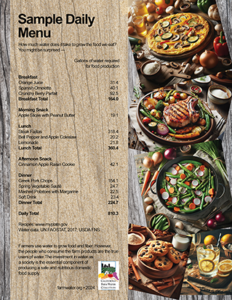Mike Wade Receives Association of California Water Agencies (ACWA) Lifetime Achievement Award
The California Farm Water Coalition (CFWC) is honored to announce that longtime Executive Director Mike Wade has received the Association of California Water Agencies (ACWA) Lifetime Achievement Award, recognizing his decades of dedicated leadership and his lasting impact on California agriculture and water stewardship.
The ACWA Lifetime Achievement Award is reserved for individuals who have made “remarkable and lasting contributions to the California water community.” This honor reflects Wade’s sustained work bringing together agriculture, water agencies, and the public, ensuring that the essential role of farm water is clearly understood and valued across California.
ACWA is the largest statewide coalition of public water agencies in the nation, representing approximately 470 public water agencies that collectively deliver about 90 percent of the water supplied to California’s cities, farms, and businesses. Through advocacy, policy leadership, and technical support, ACWA provides a unified platform for California water agencies addressing issues ranging from infrastructure and water supply reliability to regulatory and legislative matters.
Under Wade’s leadership, the California Farm Water Coalition evolved from a grassroots water-awareness initiative founded in 1989 into the state’s foremost educational voice for irrigated agriculture. Over nearly three decades of service, Wade helped build a broad coalition of farmers, water districts, and ag-related businesses statewide.
Key achievements under his leadership include:
· Statewide coalition building: Wade played a central role in expanding the Coalition into a robust statewide network representing water districts, individual growers, and agricultural businesses across the Sacramento and San Joaquin valleys, the Central Coast, the Imperial and Coachella valleys, and Southern California.
· Trusted, fact-based communication: Under his direction, the Coalition strengthened its commitment to providing research-driven, transparent information about agricultural water use. This ensured that public- and policymaker-facing communications accurately reflected real-world water management, environmental awareness, and food production needs.
· Comprehensive outreach and education: Wade guided the development of wide-reaching educational materials—including fact sheets, infographics, videos, and curriculum resources—used by schools, media outlets, and consumers throughout California.
· Strengthening farm-to-consumer connections: Through the consumer-facing Cultivate California program, expanded under Wade’s leadership in collaboration with the Cultivate California Steering Committee, the Coalition helped consumers understand how water supports the farms that supply their food. Social media campaigns, influencer farm tours, and multimedia outreach helped translate agricultural water use into relatable, everyday context.
Wade’s tenure reflects a career of coalition-building and public engagement. Through coordinated messaging, strategic communication, and fact-based educational efforts, he helped establish the Coalition as a trusted voice on water-use efficiency, productive agriculture, and the essential role of reliable water supplies in sustaining California’s food production.
The ACWA Lifetime Achievement Award honors individuals whose careers have made a durable, positive impact on the state’s water landscape. By recognizing Mike Wade, ACWA highlights decades of leadership that strengthened partnerships between agriculture, water agencies, and the communities they serve.
“Mike Wade leaves a legacy of advocacy, integrity, and leadership,” said Greg Johnson, President of the California Farm Water Coalition. “His ability to communicate the critical link between water and food production has been instrumental in helping California’s farmers and ranchers maintain their essential role in feeding the nation.”
Wade is stepping down in February following 27 years of service as the Coalition’s executive director.
